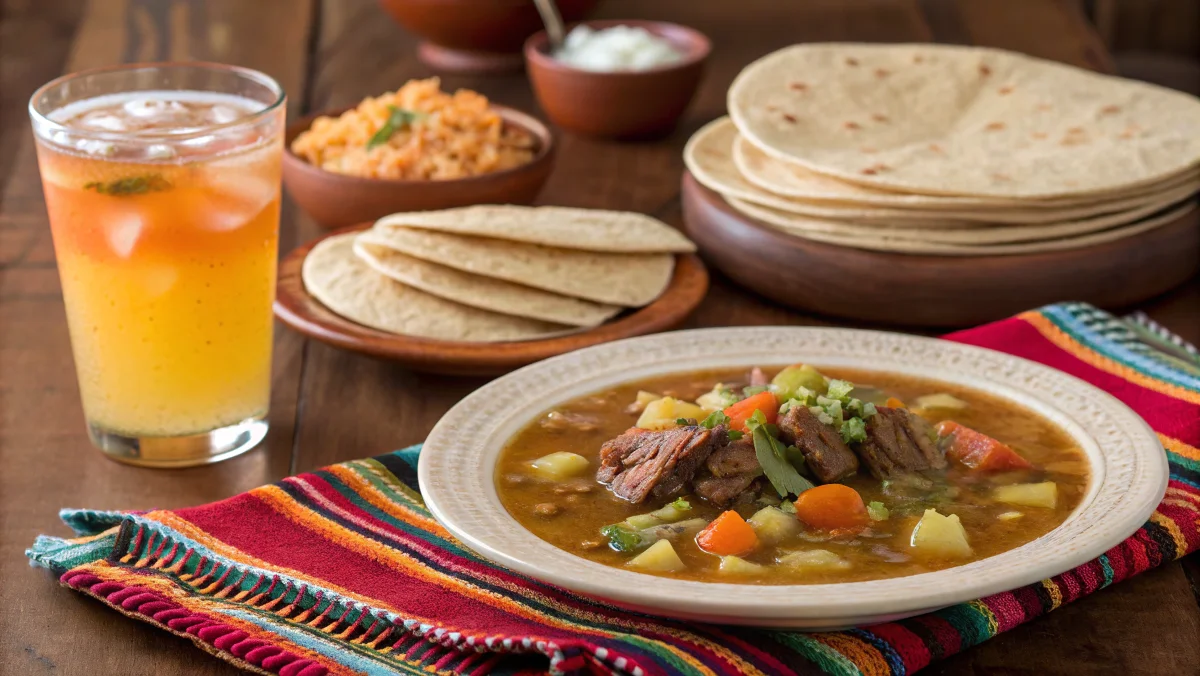As a fan of comforting and hearty dishes, Caldo de Res is a meal that never fails to warm the soul. This traditional Mexican beef soup is more than just food—it’s a cultural treasure passed down through generations. Made with tender beef, fresh vegetables, and a flavorful broth, it’s as nourishing as it is delicious. Each bite invites you to savor the essence of Mexican culinary tradition.
If you’re wondering how to eat Caldo de Res or looking to enhance the experience, this guide will show you how to enjoy it to the fullest. Pair it with warm tortillas, a squeeze of lime, and your favorite salsa for an authentic and flavorful meal!
For a deeper dive into the flavors and preparation of this iconic dish, check out Caldo de Res: The Hearty Mexican Soup That Will Warm Your Soul. It’s the perfect resource for creating a soup that’s packed with tradition and comfort.
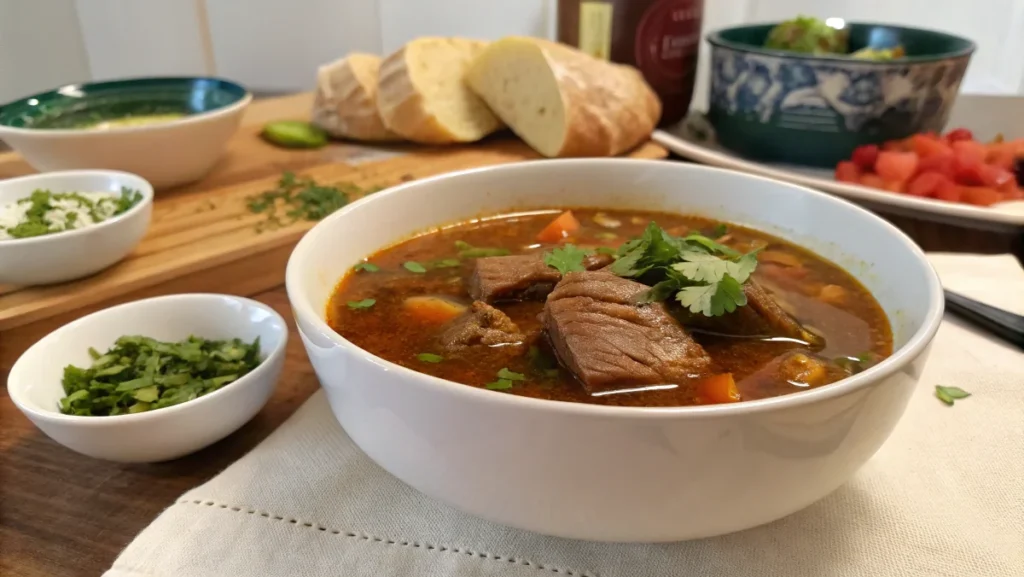
Table of Contents
What is Caldo de Res?
Origins of Caldo de Res
How to Eat Caldo de Res starts with understanding its rich heritage. Caldo de res, which translates to “beef soup,” is a traditional dish in Mexican cuisine. It’s a rustic meal often associated with family gatherings and celebrations. The origins of this dish date back to when humble ingredients like beef shank and seasonal vegetables were simmered together to create a wholesome meal. Today, it remains a beloved comfort food across Mexico and among those who appreciate authentic Mexican flavors.
Key Ingredients and Their Role
The ingredients in caldo de res are simple yet flavorful. Here’s a quick look at the core components:
- Beef Shank and Marrow Bones: These provide a rich, meaty flavor while the marrow adds a creamy texture.
- Vegetables: Traditional choices include corn, carrots, cabbage, chayote, and potatoes. These not only add color but also a variety of nutrients.
- Aromatic Base: Onions, garlic, and herbs like cilantro bring depth to the broth.
- Seasoning: Salt, pepper, and sometimes lime juice for a tangy twist.
This simple combination creates a dish that’s not only delicious but also nutrient-dense.
Preparing Caldo de Res for Eating
Serving Temperature
How to Eat Caldo de Res begins with serving it hot. The warmth enhances its rich flavors and adds to the comforting dining experience. Always serve it steaming, especially on cold days or during rainy weather, when its hearty broth feels the most satisfying.
Properly Garnishing the Dish
Garnishes elevate the flavors of caldo de res. Some common toppings include:
- Fresh Lime Wedges: Squeezing lime into the soup balances the richness of the beef with a bright citrusy tang.
- Cilantro: Adds a fresh, herbal flavor that complements the broth.
- Diced Onion: Brings a sharp, crunchy contrast to the soft ingredients.
- Spicy Salsa: For those who love a kick of heat, a dollop of salsa enhances the flavor.
Garnishing isn’t just about taste—it’s an essential part of the experience. If you’re learning how to eat Caldo de Res, don’t skip this step! Adding lime, cilantro, or salsa enhances the flavors and makes the dish even more enjoyable.
How to Eat Caldo de Res Step-by-Step
Caldo de res is more than just soup—it’s a whole experience! Here’s a step-by-step guide to eating it like a pro:
Step 1: Savoring the Broth First
To truly enjoy how to eat Caldo de Res, start by tasting the broth on its own. This lets you savor the essence of the dish. The broth, infused with the flavors of tender beef, fresh vegetables, and seasonings, is the heart of caldo de res. Use a spoon to sip it slowly, appreciating its warmth and rich depth of flavor.
Step 2: Combining Beef and Vegetables
After enjoying the broth, explore the main components of Caldo de Res. Use your fork or spoon to combine a piece of tender beef with vegetables like carrots, corn, or potatoes. This approach ensures every bite is filled with a delightful mix of textures and flavors, showcasing the heartiness of the dish.
Step 3: Adding Sides Like Tortillas
Warm corn tortillas are the ultimate companion when learning how to eat Caldo de Res. Dip them into the savory broth for an enhanced burst of flavor or use them to scoop up tender beef and hearty vegetables. For a more filling meal, pair the soup with a portion of fluffy rice.
By incorporating these simple tips, you can fully savor the depth of flavors this traditional dish has to offer. How to eat Caldo de Res is all about embracing its comforting and versatile nature, bringing joy to every meal.
If you’re looking for another delicious recipe to explore, try this Sweet and Sour Meatballs Recipe – Simple and Flavorful. Its balance of tangy and savory flavors makes it a perfect addition to your repertoire of comforting dishes.
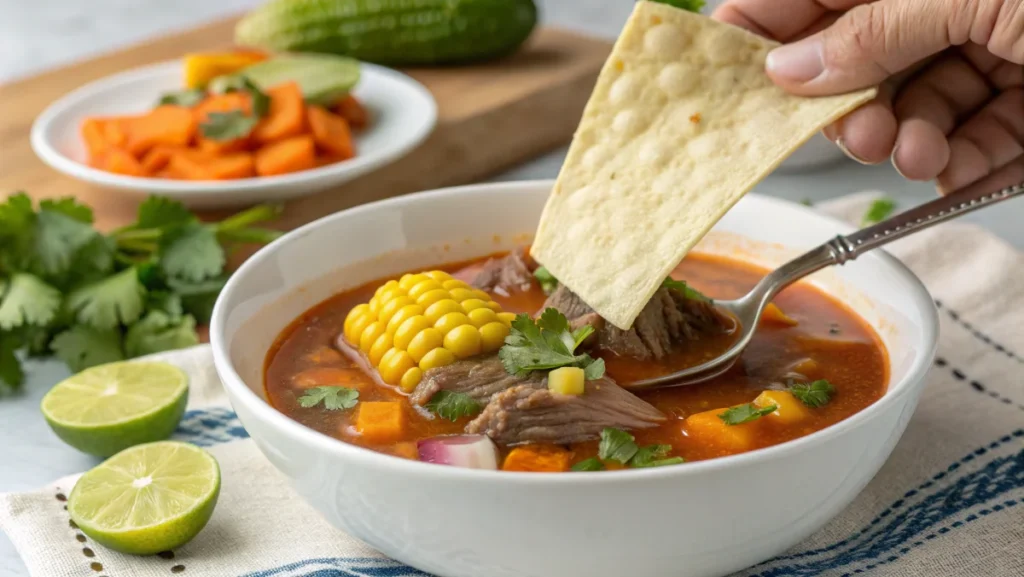
Nutritional Value of Caldo de Res
Rich in Protein and Vitamins
Caldo de res is not only delicious but also incredibly nutritious. The beef shank is a fantastic source of protein, which is essential for building and repairing tissues. Marrow bones, often used in this soup, provide essential minerals like calcium and magnesium, while also adding a unique creamy texture to the broth.
The vegetables in caldo de res contribute to its nutritional profile. Carrots provide vitamin A for healthy vision, while cabbage and potatoes are rich in fiber, aiding digestion. Additionally, corn adds a touch of natural sweetness along with carbohydrates for energy.
Low-Calorie and Filling
Despite being hearty and comforting, Caldo de Res is relatively low in calories. Its blend of protein, fresh vegetables, and flavorful broth makes it both satisfying and light. It’s an ideal meal for anyone looking to enjoy a healthy option without sacrificing taste.
Hydration Benefits
Because it’s broth-based, caldo de res helps with hydration. The warm liquid not only soothes the body but also replenishes fluids, especially during illness or colder seasons.
This wholesome combination of nutrients makes caldo de res a great choice for anyone looking to enjoy a balanced and nourishing meal.
Common Mistakes to Avoid While Eating Caldo de Res
Skipping the Garnishes
One of the biggest mistakes you can make is forgetting the garnishes. Fresh lime juice, cilantro, and onions are essential to enhance the soup’s flavors. Without them, you miss out on the zesty, aromatic balance that makes caldo de res so special.
Overlooking the Marrow
The marrow inside the beef bones is a hidden treasure. Rich in nutrients and bursting with flavor, it’s often considered the best part of the dish. Use a small spoon to scoop out the marrow and mix it into the broth for an extra creamy texture.
Not Pairing It with Tortillas or Sides
While caldo de res is hearty on its own, pairing it with sides like tortillas or rice takes it to another level. Don’t make the mistake of skipping these complementary additions, as they help soak up the broth and add to the overall experience.
Overloading on Salsa
While salsa adds a welcome kick to caldo de res, using too much can overpower the delicate flavors of the broth. Add it sparingly and taste as you go to strike the perfect balance.
Avoiding these common mistakes ensures you get the most out of your caldo de res experience, both in terms of flavor and nutrition.
Storage and Reheating Tips for Caldo de Res
How Long Does Caldo de Res Last in the Fridge?
Caldo de res is best consumed fresh, but it can be stored for later enjoyment. When stored in an airtight container, it remains safe to eat for up to 4 days in the refrigerator. If you plan to keep it longer, freezing is an excellent option—it can last up to 3 months in the freezer while retaining its flavor and nutritional value.
To ensure the soup doesn’t spoil:
- Allow it to cool completely before refrigerating.
- Avoid leaving it at room temperature for more than 2 hours to prevent bacterial growth.
Best Reheating Practices
Reheating caldo de res properly is crucial to maintaining its texture and flavor. Follow these tips:
- Stovetop Method: Pour the soup into a pot and heat it over medium heat until it’s steaming hot. Stir occasionally to ensure even heating.
- Microwave Method: Use a microwave-safe bowl and cover it with a vented lid. Heat the soup in 1-minute intervals, stirring in between to avoid uneven heating.
For frozen caldo de res, thaw it in the refrigerator overnight before reheating.
Maintaining Freshness
When reheating Caldo de Res, adding fresh garnishes like lime and cilantro can instantly revive its vibrant flavors. To maintain the texture of the vegetables and the tenderness of the beef, remember one key tip in how to eat Caldo de Res: avoid reheating it multiple times for the best taste and quality.
By following these storage and reheating tips, you can enjoy your Caldo de Res with the same great flavor as when it was freshly made. For more tips on cooking and serving flavorful dishes, explore the Flat Iron Steak: A Complete Guide to Cooking, Choosing, and Serving. It’s an excellent resource for perfecting your steak game and enhancing your culinary skills.
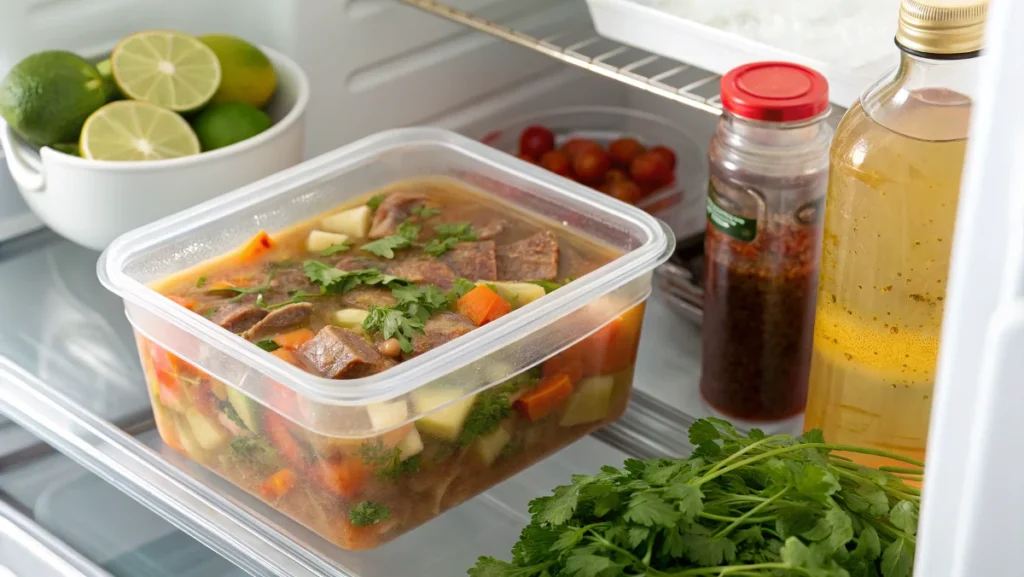
Cultural Significance of Caldo de Res in Mexico
A Dish for All Occasions
How to Eat Caldo de Res begins with understanding its cultural significance. Caldo de Res holds a special place in Mexican culture as a dish that transcends seasons and occasions. It’s often served at family gatherings, celebrations, and even as a comforting meal during illness. More than just food, it’s a symbol of care, connection, and togetherness.
Regional Variations
While the core ingredients of caldo de res remain the same, different regions in Mexico add their unique touches. For example:
- In some areas, chayote squash is a popular addition.
- Others might include spicy peppers or use locally available herbs to flavor the broth.
These variations showcase the diversity of Mexican cuisine and how each community adapts the dish to reflect their local traditions.
Sharing Caldo de Res with Loved Ones
One of the most heartwarming aspects of how to eat Caldo de Res is its communal nature. The process of preparing the soup—chopping fresh vegetables, simmering the flavorful broth, and sharing conversations in the kitchen—brings people together. Once served, families often gather around the table, enjoying each bowl and deepening bonds over this comforting and nourishing dish.
For many, Caldo de Res isn’t just food; it’s a heartfelt reminder of home, family, and tradition.
If you’re inspired to explore more hearty family meals, check out these Chicken Thigh Recipes. Packed with flavor and variety, they’re perfect for creating your next shared dining experience.
Answering FAQs About Caldo de Res
1. How healthy is Caldo de Res?
Caldo de res is incredibly healthy, thanks to its combination of protein-rich beef, nutrient-dense vegetables, and flavorful broth. The soup is low in fat but high in essential vitamins and minerals, such as:
- Protein: Supports muscle repair and growth.
- Vitamin A: Found in carrots, essential for vision and immune health.
- Iron and Calcium: Derived from the marrow bones, promoting strong bones and healthy blood cells.
It’s also a hydrating and satisfying meal that fits well into a balanced diet.
2. How much is a serving of Caldo de Res?
A typical serving of caldo de res is about 2 cups, but portions can vary based on appetite and side dishes. For a full meal, pair it with warm tortillas, rice, or a salad.
3. What does caldo mean in Mexico?
In Mexican cuisine, the word caldo translates to “soup” or “broth.” Unlike lighter soups, caldos are hearty and filling, made with ingredients like meat, bones, and vegetables. If you’re wondering how to eat Caldo de Res, you’ll discover that this dish is one of the most beloved and satisfying examples of Mexico’s rich culinary tradition.
4. How long is Caldo de Res good for in the fridge?
When stored properly in an airtight container, caldo de res remains fresh for up to 4 days in the refrigerator. Beyond this timeframe, it’s best to freeze it to preserve its quality and flavor.
These FAQs address common concerns while showcasing why caldo de res is such a beloved dish worldwide.
Tips for Pairing Caldo de Res with Drinks and Sides
Best Beverage Pairings
The hearty and savory flavors of caldo de res pair beautifully with a variety of beverages. Some popular options include:
- Agua Fresca: Light and refreshing drinks like horchata or tamarind agua fresca balance the soup’s richness.
- Mexican Beer: A cold cerveza, such as Corona or Modelo, complements the dish’s earthy flavors.
Side Dishes to Enhance Your Meal
Caldo de res is a meal on its own, but adding sides makes the experience even better. Consider:
- Corn Tortillas: Soft and warm, they’re perfect for dipping into the broth or scooping up beef and vegetables.
- Mexican Rice: A side of seasoned rice adds heartiness to the meal.
- Crusty Bread: For a non-traditional option, crusty bread works well to soak up the flavorful broth.
Pairing caldo de res with these drinks and sides elevates the meal, making it suitable for casual dinners or festive occasions.
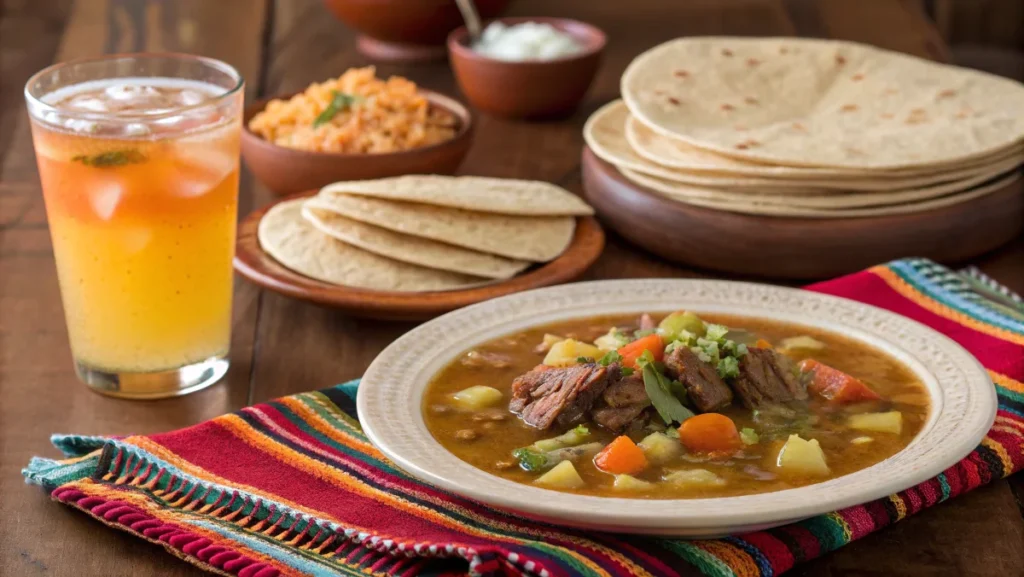
Conclusion: Savoring the Ultimate Caldo de Res Experience
Caldo de Res is more than just soup—it’s a symbol of tradition and togetherness. From its rich broth to tender beef and vibrant vegetables, this hearty dish embodies the essence of Mexican cuisine.
If you’re learning how to eat Caldo de Res, enhance your experience by adding lime, cilantro, and salsa, pairing it with warm tortillas, or enjoying it alongside a refreshing drink. Whether freshly made or reheated, Caldo de Res always delivers comfort, flavor, and a sense of connection to the table.
If you’re planning meals ahead, check out Can I Prep Beef Wellington the Night Before? for tips to simplify your cooking routine.

